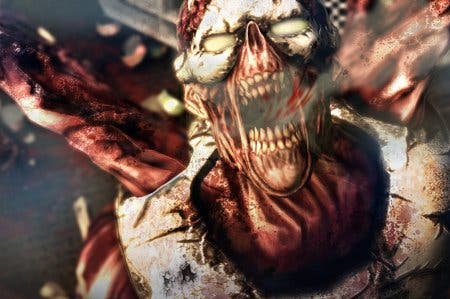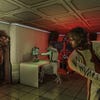Afterfall: Insanity Review
Mad for it.
Where do you draw the line between indie and mainstream gaming? Is it purely a financial distinction, with one being produced for peanuts and the other benefiting from healthy sacks of cash, or is it an ideology, with independence not only from corporate interests but from conventional design?
These are the questions that buzzed around my head while playing Afterfall: Insanity, a game produced over several years by Intoxicate Studios, a group of Polish coding enthusiasts who coordinated their efforts over internet forums. They've created something that looks incredibly impressive, with Unreal 3 powered visuals and a throbbing orchestral soundtrack. They've also created something so generic that you can't help wondering if it was worth the effort.
It's a third-person survival-horror shooter, set in a post-apocalyptic dystopia where humanity has survived a cataclysmic war by retreating to underground bunkers. Topside, the world now belongs to mutants and monsters. Below, people live in sterile comfort, ruled by totalitarian leaders and subject to the madness of Confinement Syndrome. It's Fallout crossed with Dead Space, basically, and while it does a serviceable job of calling to mind its inspirations, it offers none of its own.
You play as Dr Albert Tokaj, a psychologist tasked with monitoring the mental state of the people living below ground. There's precious little time to establish his backstory, however, as within 10 minutes of starting the game Tokaj is accused of some mysterious crime and declared a public menace. Guards approach with murderous intent, and this ordinary doctor fights back by grabbing a fireaxe and decapitating them. Perhaps this is how you prove your innocence in the future.
Of course, things aren't what they seem, and this introductory sequence does a good job of creating an obvious but enjoyable off-kilter atmosphere. That doesn't last for long and you're soon firmly in traditional action territory and, from that point on, the game is as trapped in its gloomy corridors and tunnels as the characters themselves. Progress is entirely linear to the point of tedium, not just narratively but geographically. The route from start to end is a straight line that takes the expected six to eight hours to walk.
"It's Fallout crossed with Dead Space, basically, and while it does a serviceable job of calling to mind its inspirations, it offers none of its own."
Puzzles occasionally break the routine, but these are rarely anything to ponder too hard over. Door hacking, for example, is simply a case of using your otherwise-useless PDA to guess a sequence of directions for a series of rotating cogs. It's basic trial-and-error stuff that never enhances or illuminates the game's world.
So the game hinges almost entirely on its combat. This, thankfully, is solid enough though never quite engaging enough to shoulder the burden of justifying the whole experience. Firearms fall into the expected models - shotguns, assault rifles and so on - while melee weapons are drawn from the environment around you. Pipes, hammers and even brooms can be swung, slightly clumsily, at enemies.
There's precious little nuance to it. Whether human or monster, foes generally run manically towards you and you mash the mouse button to smack them away with whatever object you're carrying. The guns have decent enough accuracy, but ammo is rare enough - and enemies dumb enough - that simply bludgeoning your way through is as good a tactic as any.
The game's two big ideas are FearLock and FreeFight, though in practice they're often barely noticeable. FearLock is what happens when Tokaj is startled or otherwise driven to panic. Vision blurs, long-range accuracy takes a dive, but melee damage is pumped up as his adrenalin surges. FreeFight is, well, a fancy way of saying you can use ordinary objects around you as weapons. Neither is particularly original or executed in a way that changes the core gameplay drastically.
Presentation, at least, is impressive. The visuals are most definitely a cut above the usual indie standard, with detailed environments and, once Tokaj ventures above ground, some decent draw distances. Lighting is atmospheric and it's clear that a lot of attention has been lavished on the look of the Afterfall world, even if it often resembles off-cuts from a thousand other games. The music, too, is appropriately cinematic but is let down by crude editing, some wobbly voice acting and a script that too often feels like it's been fed through the Babelfish translation website rather than truly localised into English. As a result, the later plot twists fall rather flat.
Visiting the game's website, it's interesting to see how Insanity has devolved from an ambitious indie RPG to this rather less interesting action title. The idea, it seems, is that this will be the game that introduces the Afterfall universe to gamers in preparation for more adventures to come.
"Even just one fresh idea could have at least given Afterfall: Insanity a reason to stand aside from the herd and distinguish itself."
If that's the case then it's a noble failure that succeeds only in making Afterfall look and feel like every other post-apocalyptic gaming scenario. There's actually a rich web of alternate history behind the game, starting in World War II with the idea that the Nazis got the atomic bomb first and ended the war in stalemate rather than defeat. A different sort of Cold War then followed, leading up to the detonation of the Entropy bomb which leads to mankind scurrying for cover beneath the earth.
Coming from a Polish developer, you'd hope that such a story would offer some pointed insights, or at least a distinctive cultural voice. As it stands, both the world and the characters that inhabit it are utterly generic, a thin soup of familiar tropes from other games, and few who play to the end without delving into the FAQ section of the website will care for the finer details of the plot or the revelations that lie before the credits.
Even just one fresh idea could have at least given Afterfall: Insanity a reason to stand aside from the herd and distinguish itself. Instead, it takes a well-worn template and delivers it with the minimum of flourish. No unique ways of attacking, no multiple pathways, no stealth or cover, no skills or abilities to enhance or earn, no sense that this is anything other than a handsomely assembled but disappointingly hollow tribute to the most basic tenets of action gaming. You go from A to B, kill everything in between, and that's it.
It shouldn't be this way, of course. You only have to look at S.T.A.L.K.E.R to see how a little imagination can transform post-apocalyptic clichés into something unique and memorable. It's always tempting to be lenient where indie developers are concerned, and if nothing else Afterfall: Insanity makes for an eye-catching calling card for Intoxicate's graphical skills, but as a game in its own right it's as middle of the road as they come.













